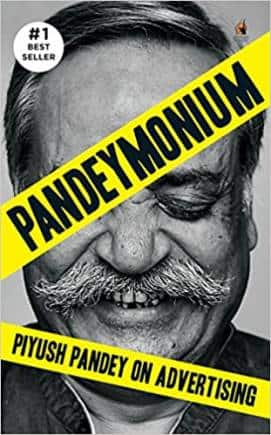Piyush Pandey was among those Indians who most effectively linked life’s priceless moments to the marketing of products and services -- a linkage that was neither essential nor inevitable.
Pandeymonium: Piyush Pandey
on Advertising
by Piyush Pandey
Published byPenguin India
Whether or not you are an advertising professional, you likely already know the name of Piyush Pandey as a celebrity advertising professional. Pandey, the lynchpin of ad agency Ogilvy India, is famous for conceptualising advertising campaigns that not only tweaked the synapses, but also twanged the heartstrings of the viewers, stoking their consumeristic aspirations in a newly liberalised Indian economy. This book tells us how Pandey thinks, what his values are, that is, what makes him tick -- a sense of curiosity about Indian life and culture, massive ambition, a drive for excellence, and a penchant for identifying heartwarming content.
 Pandey was among those Indians who most effectively linked life’s priceless moments to the marketing of products and services -- a linkage that was neither essential nor inevitable. If this is a form of manipulation, then it is also an indictment of the entire field of advertising, which is designed to create demand where it often does not exist. Pandey clearly does not think so; he only praises advertising’s potential to bring about social change, without dwelling at length on the ethics of advertising itself, and what an ethical form of advertising might look like. Curious, then that Pandey’s values as a communicator are conveyed right at the beginning of the book: “Whatever you say, say it with respect for the audience, say it in a context that the audience can understand, say it spontaneously, say it without fear, say it not to intimidate or frighten, but to delight”.
Pandey was among those Indians who most effectively linked life’s priceless moments to the marketing of products and services -- a linkage that was neither essential nor inevitable. If this is a form of manipulation, then it is also an indictment of the entire field of advertising, which is designed to create demand where it often does not exist. Pandey clearly does not think so; he only praises advertising’s potential to bring about social change, without dwelling at length on the ethics of advertising itself, and what an ethical form of advertising might look like. Curious, then that Pandey’s values as a communicator are conveyed right at the beginning of the book: “Whatever you say, say it with respect for the audience, say it in a context that the audience can understand, say it spontaneously, say it without fear, say it not to intimidate or frighten, but to delight”.
The book is structured as a series of anecdotes culminating in advice from Pandey’s playbook for advertising professionals. For instance, Pandey writes of Ogilvy’s rules on the use of music in their commercials. “Suresh Mullick (National Creative Director, and Pandey’s mentor) taught me... not to create music and lyrics that take the brief literally. The second is never to force music onto the consumer. The third is not to ‘sing’ brand names.” Each anecdote, which is too brief to be called a case study, comes with nuggets of advice such as these.
Pandey has a freewheeling style of narration, and sometimes it is hard to discern the thrust or flow of a chapter. There are passages where facts are simply mentioned in passing to whet our appetite but not to slake our hunger through elaboration. For instance, in a chapter on Ogilvy India’s work with family-run businesses, we are told in about 125 words that Pandey considers it his personal failure never to have worked with the Mahindra Group of companies. The chapter ends there abruptly. Why mention this at all if you’re not going to explain it adequately?
Happily, though, Pandey gives us a glimpse into his mode of generating advertising ideas. He writes, “Whenever I feel bereft of ideas or hit a block, I find inspiration by rewinding life to my childhood and going back to my formative years. That’s when the mind was pure, unafraid, unconstructed and unfettered”. That points us to the source of the emotional energy of Pandey’s ideas.
Many of his famous ad campaigns are mentioned in the book. I will single out, however, his agency’s work on the campaign done for the Bharatiya Janata Party ahead of the 2014 Lok Sabha elections, including the famous slogan, Ab ki baar Modi sarkar. This chapter, like the others, is dealt with too breezily; more detail about the rationale behind the choice of messaging tone and content would have further benefited the students of advertising whom this book will naturally attract.
Pandey also devotes attention to the future of the advertising business in India. Of course, his book was written before the COVID crisis hit; his bullish predictions of the ad industry growing by 11-12 percent year on year now seem like fiction.
To sum up: this book makes the general audience relive their memories of landmark ad campaigns that defined the consciousness of post-liberalisation India. But the book is not written in order to be a comprehensive explainer of advertising to the lay reader. What the book does do is to give us a glimpse into Pandey’s mindset and thought process; so the book will be of interest to advertising professionals and students of the subject.
Suhit Kelkar is a freelance Journalist. He is the author of the poetry chapbook named The Centaur Chronicles.








